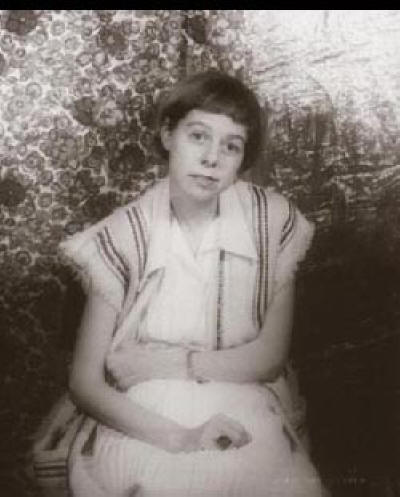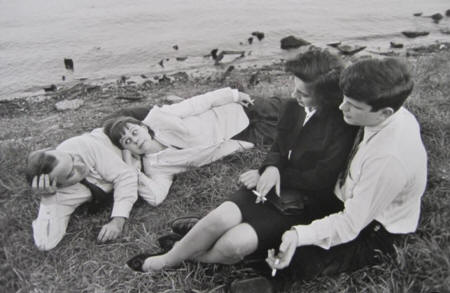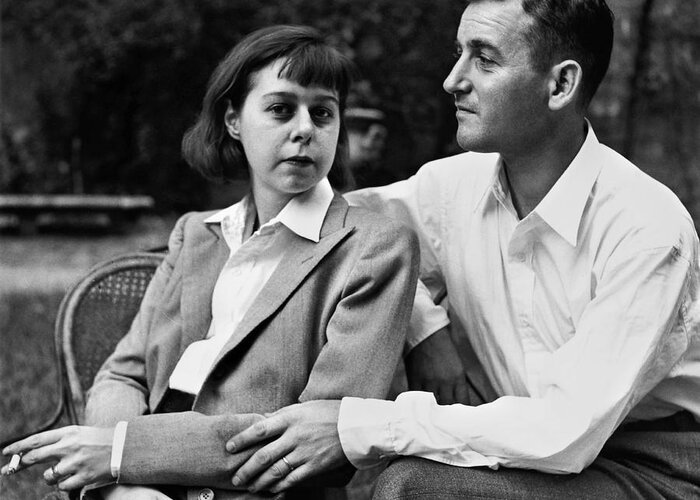

Husband Reeves McCullers
Queer Places:
1519 Stark Ave, Columbus, GA 31906, Stati Uniti
423 13th St, Columbus, GA 31901, Stati Uniti
Columbus High School, 1700 Cherokee Ave, Columbus, GA 31906, Stati Uniti
311 East Blvd, Charlotte, NC 28203
806 Central Ave, Charlotte, NC 28204
119 N Cool Spring St, Fayetteville, NC 28301
New York University, New York, 10003, Stati Uniti
Juilliard School, 60 Lincoln Center Plaza, New York, NY 10023, Stati Uniti
Columbia University (Ivy League), 116th St and Broadway, New York, NY 10027
February House, 7 Middagh St, Brooklyn, NY 11201, Stati Uniti
321 W 11th St, New York, NY 10014
Dakota Apartments, 1 W 72nd St, New York, NY 10023, Stati Uniti
131 S Broadway, Nyack, NY 10960, Stati Uniti
Oak Hill Cemetery, 140 N Highland Ave, Nyack, NY 10960, Stati Uniti
 Carson
McCullers (February 19, 1917 – September 29, 1967) was an
American novelist, short story writer, playwright, essayist, and poet. Her first
novel, ''The Heart Is a Lonely Hunter'', explores the spiritual isolation of
misfits and outcasts in a small town of the U.S.
South. Her other novels have similar themes and most are set in the deep
South. She had erotically charged relationship with both
Elizabeth Bowen in the 1950s.
Carson
McCullers (February 19, 1917 – September 29, 1967) was an
American novelist, short story writer, playwright, essayist, and poet. Her first
novel, ''The Heart Is a Lonely Hunter'', explores the spiritual isolation of
misfits and outcasts in a small town of the U.S.
South. Her other novels have similar themes and most are set in the deep
South. She had erotically charged relationship with both
Elizabeth Bowen in the 1950s.
McCullers’ oeuvre is often described as Southern Gothic and
indicative of her southern roots. However, McCullers penned all of her work
after leaving the South, and critics also describe her writing and eccentric
characters as universal in scope. Her stories have been adapted to stage and
film. A stagework of her novel ''The Member of the Wedding'' (1946), which
captures a young girl's feelings at her brother's wedding, made a successful
Broadway run in 1950–51.
She was born Lula Carson
Smith in Columbus, Georgia in 1917 to Lamar Smith, a jeweler, and
Marguerite Waters.[1] She was named after her maternal grandmother, Lula Carson
Waters. She had a younger brother, Lamar, Jr. and a younger sister, Marguerite.[2] Her mother’s grandfather was a planter and Confederate war hero. Her
father was a watchmaker and jeweler of French Huguenot descent. From the age
of ten she took piano lessons; when she was fifteen her father gave her a
typewriter to encourage her story writing.
Smith graduated from
Columbus High School. In September
1934, at age 17, she left home on a steamship bound for New York City,
planning to study piano at the Juilliard School of Music. After falling ill
with rheumatic fever she returned to Columbus to recuperate, and she changed
her mind about studying music.[3] Returning to New York she worked in menial
jobs while pursuing a writing career; she attended night classes at Columbia
University and studied creative writing under the Texas writer Dorothy
Scarborough and with Sylvia Chatfield Bates at Washington Square College of
New York University. In 1936 she published her first work. "Wunderkind", an
autobiographical piece that Bates admired, depicted a music prodigy's adolescent
insecurity and losses. It first appeared in ''Story''
magazine and is collected in ''The Ballad of the Sad Cafe.''[4]

George Davis and Carson McCullers
Elmer Holmes Bobst Library, 70 Washington Square S, New York, NY 10012
Dakota Apartments, 1 W 72nd St, New York, NY 10023, Stati Uniti
321 W 11th St

From 1935 to 1937,
as her studies and health dictated, she divided her time between Columbus and
New York. In September 1937, aged 20, she married an ex-soldier and aspiring
writer, Reeves McCullers. They began their married life in Charlotte, North
Carolina, where Reeves had found work.
Maxim Lieber
was her literary agent in 1938 and intermittently thereafter. In 1940, at the
age of 23, writing in the Southern Gothic or perhaps Southern realist traditions, McCullers completed her first novel, ''The Heart
Is a Lonely Hunter''.[5][6] (The title was suggested by her editor
and was taken from a Fiona MacLeod poem, "The Lonely Hunter"). At the time
the novel was thought to suggest an anti-Fascist message.[7]
McCullers published eight books; the best known are The
Heart Is a Lonely Hunter (1940), Reflections in a Golden Eye (1941) and
The Member of the
Wedding (1946). The novella The Ballad of the Sad Café (1951)
depicts loneliness and the pain of unrequited love; at the time of its writing,
McCullers was a resident at Yaddo, the artists' colony in Saratoga, New
York. It was dramatized by Edward Albee and
closed on Broadway after 123 performances.
In The Member of the Wedding, McCullers describes the
feelings of a young girl at her brother's wedding. The Broadway stage adaptation
of the novel had a successful run in 1950–51 and was produced by the Young
Vic in London in September 2007. Challenged by a critic that her novel contained
no drama, McCullers started the adaptation when she was visiting
Tennessee Williams on
Nantucket Island. Comforted by being part of a threesome (Williams, Williams's
companion Pancho Rodriguez, and
herself), McCullers created a play that eventually earned her over a million
dollars on Broadway.
Many know her works largely by their film
adaptations. The Heart Is a Lonely Hunter was adapted as a film with the same title in 1968, with Alan
Arkin in the lead role. ''Reflections in
a Golden Eye'' was directed by John Huston (1967) and starred Marlon
Brando and Elizabeth Taylor. Huston, in his autobiography, ''An Open
Book'' (1980), said: "I first met Carson McCullers during the war
when I was visiting Paulette Goddard and Burgess Meredith in upstate New
York. Carson lived nearby, and one day when Buzz and I were out for a walk she
hailed us from her doorway. She was then in her early 20s, and had already
suffered the first of a series of strokes. I remember her as a fragile thing
with great shining eyes, and a tremor in her hand as she placed it in mine. It
wasn't palsy, rather a quiver of animal timidity. But there was nothing timid or
frail about the manner in which Carson McCullers faced life. And as her
afflictions multiplied, she only grew stronger."
Carson and Reeves McCullers divorced in 1941. After separating from
Reeves she moved to New York to live with George
Davis, the editor of ''Harper's Bazaar''. She became a member of
February House, an art commune in Brooklyn.[8] Among her friends were
W.H. Auden, Benjamin Britten,
Gypsy Rose Lee and the writer couple
Paul Bowles and Jane Bowles. After World War II McCullers lived
mostly in Paris. Her close friends during these years included
Truman
Capote and Tennessee Williams. During this period of separation, Reeves
had a love relationship with the composer David
Diamond, and the two lived together in Rochester, NY.[9]
She fell in love with a number of women and pursued them sexually with great
aggression, but seems not to have succeeded in having sex with any of them. Her
most documented and extended love obsession was with
Annemarie Schwarzenbach
of whom she once wrote "She had a face that I knew would haunt me for the rest
of my life." In her autobiography, McCullers reports that the two shared one
kiss. McCullers' passion, however, was not reciprocated, and the two remained
friends with McCullers dedicating her next novel, Reflections in a Golden Eye, to her.[10]
Sarah Schulman writes: "There
is the infamous obsession with Katherine Anne Porter and a much-implied
ongoing “friendship” with Gypsy Rose Lee. But if Carson ever actually had
sex with a woman, even Tennessee Williams didn’t hear of it. According to
McCullers’s brilliant biographer, Virginia Spencer Carr, Carson did brag to
her male cousin that she’d had sex with Gypsy once. But if that was the case,
she never mentioned it to any of her gay friends. In the absence of reciprocated
lesbian love and the inability to consummate lesbian sex, McCullers still wore a
lesbian persona in literature and in life. She clearly wrote against the grain
of heterosexual convention, wore men’s clothes, was outrageously aggressive in
her consistently failed search for sex and love with another woman, and formed
primary friendships with other gay people." In 1945,
Carson and Reeves McCullers remarried. Three years later, while severely
depressed, she attempted suicide. In 1953 Reeves tried to convince her to commit
suicide with him, but she fled and Reeves killed himself in their Paris hotel
with an overdose of sleeping pills.[11] Her bittersweet
play ''The Square Root of Wonderful'' (1957) drew upon these traumatic
experiences. The potential suicide of Carson’s father may have foreshadowed if
not influenced these events. This break from the reported story of his sudden
death by heart attack was first published in 2003 by Virginia Spencer Carr in
the preface to her updated biography, ''The Lonely Hunter''. The suggestion was further explored in "A Member of the Family," an article on
Lamar Smith, by Daniel Bellware in the Fall 2017 issue of ''Muscogiana''
published by Columbus State University.[12]
McCullers dictated her unfinished autobiography, ''Illumination and Night
Glare'' (1999), during the final months of her life. Her home from 1945 to 1967 in South Nyack, New York, was listed on the
National Register of Historic Places in 2006.[13]
McCullers suffered
throughout her life from several illnesses and from alcoholism. She had
rheumatic fever at the age of 15 and suffered from strokes that began in
her youth. By the age of 31 her left side was entirely paralyzed. She lived the
last twenty years of her life in Nyack, New York, where she died on
September 29, 1967, at the age of 50, after a brain hemorrhage. She was buried
in Oak Hill Cemetery.[14]
McCullers's childhood home in
Columbus, Georgia, is now owned by Columbus State University and is the
central location of the university's Carson McCullers Center for Writers and
Musicians.
McCullers's physician and longtime friend, Dr. Mary E. Mercer, bequeathed
the house in Nyack to Columbus State University's Carson McCullers Center for
Writers and Musicians, the same center that owns and operates out of
McCullers's childhood home in Columbus, Georgia. After
Dr. Mercer's death in late April 2013, the McCullers Center inherited not only
the house but also many artifacts and documents that shed light on the last ten
years of McCullers's life.
Because of the generosity of Dr. Mercer,
Columbus State University is one of the very few universities to own two homes
of a single author and now houses the world's most extensive research collection
on McCullers. An endowment in Dr. Mercer's name also has been created to
continue these efforts in the curation and preservation of McCullers's legacy.
My published books: